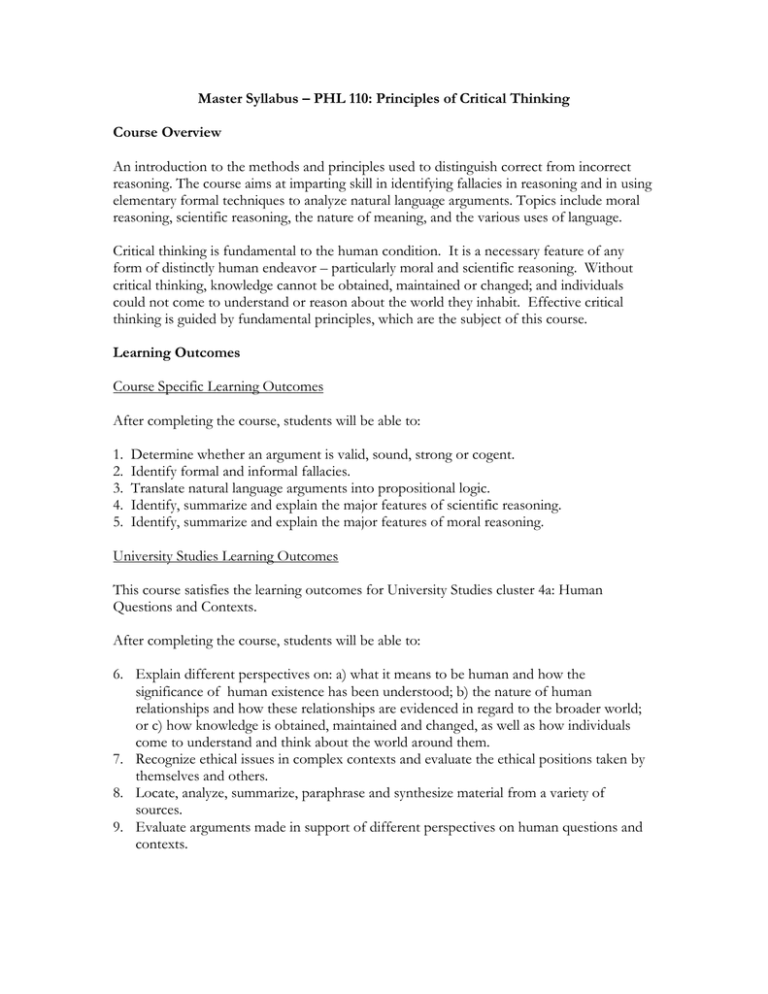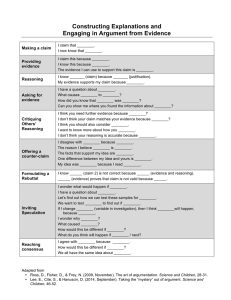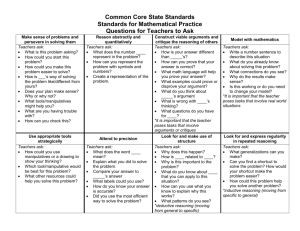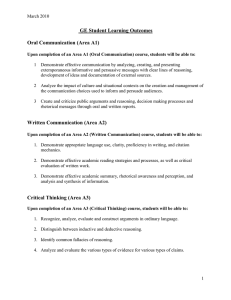Master Syllabus – PHL 110: Principles of Critical Thinking Course Overview
advertisement

Master Syllabus – PHL 110: Principles of Critical Thinking Course Overview An introduction to the methods and principles used to distinguish correct from incorrect reasoning. The course aims at imparting skill in identifying fallacies in reasoning and in using elementary formal techniques to analyze natural language arguments. Topics include moral reasoning, scientific reasoning, the nature of meaning, and the various uses of language. Critical thinking is fundamental to the human condition. It is a necessary feature of any form of distinctly human endeavor – particularly moral and scientific reasoning. Without critical thinking, knowledge cannot be obtained, maintained or changed; and individuals could not come to understand or reason about the world they inhabit. Effective critical thinking is guided by fundamental principles, which are the subject of this course. Learning Outcomes Course Specific Learning Outcomes After completing the course, students will be able to: 1. 2. 3. 4. 5. Determine whether an argument is valid, sound, strong or cogent. Identify formal and informal fallacies. Translate natural language arguments into propositional logic. Identify, summarize and explain the major features of scientific reasoning. Identify, summarize and explain the major features of moral reasoning. University Studies Learning Outcomes This course satisfies the learning outcomes for University Studies cluster 4a: Human Questions and Contexts. After completing the course, students will be able to: 6. Explain different perspectives on: a) what it means to be human and how the significance of human existence has been understood; b) the nature of human relationships and how these relationships are evidenced in regard to the broader world; or c) how knowledge is obtained, maintained and changed, as well as how individuals come to understand and think about the world around them. 7. Recognize ethical issues in complex contexts and evaluate the ethical positions taken by themselves and others. 8. Locate, analyze, summarize, paraphrase and synthesize material from a variety of sources. 9. Evaluate arguments made in support of different perspectives on human questions and contexts. Sample Texts Howard-Snyder(s) and Wasserman. The Power of Logic (4th edition). McGraw Hill. Copi and Cohen. Introduction to Logic (14th edition). Pearson. Vaughn. The Power of Critical Thinking. Oxford University Press. Example Assignments (A) An exam wherein students must translate various natural language arguments into propositional logic, identify the form of the arguments they’ve translated, determine if they are valid, sound, strong or cogent, and if none of these identify the fallacy committed by the argument. Satisfies learning outcomes 1,2,3,6, and 8. (B) A writing assignment wherein students must translate Socrates’ argument against Divine Command Theory (the theory that morality is constituted by God’s commands) into formal propositional logic; and students must evaluate the argument for validity and soundness. Satisfies learning outcomes 1,2,3,5,6,7,8, and 9. (C) Answer the following question: Each element, such as hydrogen and iron, has a set of gaps - wavelengths that it absorbs rather than radiates. So, if those wavelengths are missing from the spectrum, you know that that element is present in the star you are observing. A. B. C. D. This argument is sound. This argument is valid but unsound. This argument is invalid but has true premises. This argument is invalid and has at least one false premise. Satisfies learning outcomes 1,2,3,4,6,8, and 9. (D) Answer the following question: According to James Rachels, if there is a moral difference between active and passive euthanasia, then there is a moral difference between killing and letting die. But, Rachels claims, there is not a moral difference between killing and letting die. Therefore, there is no moral difference between active and passive euthanasia. A. This argument is sound. B. This argument is valid but unsound. C. This argument is invalid but has all true premises. D. This argument is invalid and has at least one false premise. Satisfies learning outcomes 1,2,3,5,6,7,8, and 9. Sample Course Outline Week 1: Basic Logical Concepts Week 2: Analyzing Arguments Week 3: Informal Fallacies Week 4: Categorical Propositions Week 5: Categorical Syllogisms Week 6: Syllogistic Fallacies Week 7: Translating Natural Language into Symbolic Forms Week 8: Symbolic Propositional Logic Week 9: Validity and Invalidity Week 10: Natural Deduction Week 11: Predicate Logic Week 12: Scientific and Causal Reasoning Week 13: Probability and Scientific Reasoning Week 14: Moral Reasoning






